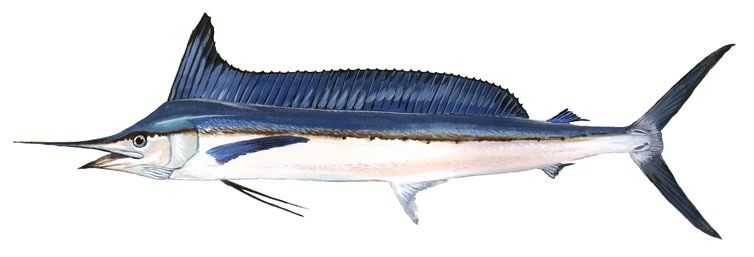Longbill Spearfish

Species Details
Tetrapturus Pfluegeri
Istiophoridae
Perciformes
Offshore, Open Water
20 - 40 lbs.
50" - 100"
Longbill Spearfish (Tetrapturus pfluegeri) Description
Unlike other billfish, the Longbill Spearfish has a slender body and a dorsal fin that’s shorter than that of a Sailfish but higher than that of a Marlin. As a billfish, the Longbill Spearfish is considered lightweight due to its body shape. Similar to that of the White and Blue Marlin, the Longbill Spearfish has a similar color with a dark navy-blue color on their back and a silvery-white underbelly.
As a billfish, its most prominent feature is its “bill” which resembles a spear. Despite being called a Longbill, its bill is only longer than that of its Shortbill cousin.
Its fins are normally a dark brown to black color. It has two anal fins which are positioned a few inches away from its falcate tailfin.
Diet and Size
Longbill Spearfishes like other billfish are piscivorous and eat other fish. Some of the fish they eat include sardines and flying fishes. If they cannot find fish, they normally feast on squids as well. They are known also to eat other medium size fish such as tuna and needlefish.
Longbill Spearfishes usually grow up to 50 to 70 inches. Like any billfish, they’re quite big. But not as big as their marlin cousins. They normally weigh around 20 to 40 lbs.
Interesting Facts about the Longbill Spearfish
- Not much is known about the Longbill Spearfishes usually because they’re such a rare catch.
- Longbill Spearfish are rumored to only live up to 5 years. The average lifespan of a Longbill Spearfish is around 2-3 years.
- In Delaware, it’s illegal to kill or keep a Longbill Spearfish.
- Upon catching, they are to be released immediately into the water.
- Longbill Spearfish are normally mistaken for their other cousins. The difficult part of telling a Blue Marlin, White Marlin, and a Longbill Spearfish apart is that you have to measure their fins side by side to have a better idea.
- Its scientific name was coined after the man that originally fished it out, Albert Pflueger Sr.
How to Release the Longbill Spearfish (in case it gets caught)
These fish are technically illegal to be fished because of their rarity and small numbers. But chances are, you’ll end up snagging it one day while trying to catch the Blue Marlin or the White Marlin. Like any Marlin angler, you’ll probably have a heavy-duty hook or ring hook that’ll snag the Longbill Spearfish by its bill. Expect it to struggle as apex predators always do. Although it’s smaller than the marlins, it doesn’t mean that it can’t body-slam into you and throw you offboard.
The best you can probably do is not bring it onboard. Doing so will just get you injured. That bill is still a bill unless you have a death wish and want your obituary to read cause of death: speared by a Longbill Spearfish. Keep it halfway in water so that it’ll ease its panic. Once the Longbill Spearfish is calmed down, you can either wriggle the hook out or just cut the line. The reason why you want it calm is so that nobody gets injured.
When fishing into the deeper waters, it's why people recommend bringing hook removers. Hook removers can consist of blades or pliers to help take it out. You may lose a hook but better that than killing an endangered fish.
Habitat and Distribution
Longbill Spearfishes are often in western waters near New Jersey and Venezuela. As a migratory fish, it won’t be surprising if you find one in the Gulf of Mexico. Like most billfishes, the Longbill Spearfish won’t be in a school. It normally travels alone.
If not at the Western waters, Longbill Spearfishes are normally found offshore and in the deeper waters. They prefer more temperate waters, migrating if the water starts getting too cold for them. Longbill Spearfishes however seem to follow wherever there are pelagic fish. For example, tunas. Usually, a Longbill Spearfish would be following wherever the tunas go. They also follow other fish that roam near the surface such as sardines. However, they are also known to stay in areas that are loaded with squid.
As a migratory fish, the ocean is the Longbill Spearfish's habitat but usually, they stay around the Atlantic Ocean.






